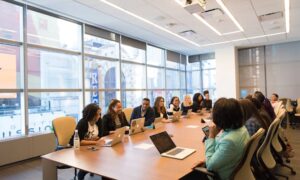Since the beginning of time, humanity has struggled to find a solution to the problem of how to access the massive volumes of information that are stored in libraries and other types of archives. A scientific and research apparatus that was based on catalogues, card libraries, scientific references, and bibliographic publications was created, and it relied on technologies that were common at various stages of society’s development until relatively recently. The most recent being the most cogent use of the scientific principles of systematization of literature, organization, and classification of funds.
In order to overcome the significant restrictions imposed by older methods of communication, modern methods of storing and exchanging information via electronic means came into being (short-lived, slow dissemination, limited access, low rates of information assimilation, etc.). The information revolution not only brought forth new circumstances for the fast expansion of society, but it also required the development of new technologies for the generation and administration of information. Because there is an unlimited amount of information, its generation and processing call for innovative technology solutions that considerably accelerate participation in scientific and social circulation and the pace of communication in whichever century you are living in. All the scientific information, which used to be unique and quite expensive, and services, like the option to buy a college coursework have become available absolutely to everyone.
Modern libraries in the information age: scientific viewpoints
It’s possible that the work done by K. Liitenen and Y. A. Schrader on the information environment, which includes libraries, goes back a long way. According to the findings of American researcher K. Liitenen, examination of the information environment may be broken down into two primary categories: resource and communication. According to the proponents of the resource approach, people who advocate for a “resource approach” are required to learn how to search and transfer information in a rapid, comprehensive, and accurate manner, as well as understand how to store information on a variety of different media. There are many different ways to think about resources, but they all centre on the concept of the information environment, which is defined in the first place as a technological system that is able to store information that gives users objective knowledge about the world, then retrieve this information for its users and distribute it further.
As a result of evolving viewpoints on the information environment as a whole, it is possible that the field of librarianship may move toward knowledge-based technology, cognitive analysis, and semantic research. This development is a distinct possibility. In the newly emerging field of knowledge engineering, expert and intelligent systems, as well as the knowledge industry, are both now undergoing research and development. Additionally, improvements are being made to the technologies that are used to show information within computer systems. In addition, social scientists have already utilized the phrase “cognitive flip” to characterize a scenario that is analogous to the current one.
When the library’s cosmetology, which refers to the study of mental activity, is established, it will become one of the most effective and all-encompassing approaches to the management of information. It creates one-of-a-kind “meta-tools” with which it is able to process enormous volumes of information by offering a wide variety of entry points into the collective memory. Because it organizes information in a hierarchical fashion and differentiates between its dispersed and its overall levels, the library provides access to universal human values and memories of the world, as well as objectivity and depth of knowledge about the environment that surrounds it.
Knowledge management: theoretical basis and technological solutions
Businesspeople began using the term “knowledge management” (KM) in the last decade of the twentieth century. When it comes to “global economy” and “century of knowledge,” business is first to grasp its value. In the modern information economy, having relevant and strategic knowledge and constantly upgrading it is a competitive advantage for organizations. Government, research, and educational organizations are all gradually adopting knowledge management practices and initiatives.
Knowledge management is an interdisciplinary field of study. As a result, it is impossible to overlook the importance of informational, communicational, and technical aspects of knowledge management while analyzing the new theory. ICT and software-technological components of contemporary web services have made it possible to execute knowledge management ideas that appeared like science fiction just a few years ago.
Knowledge, data repositories and experts
The purpose of a strategy for managing knowledge is to ensure that everyone within an organization and its surrounding environment has access to the information they require in order to boost the overall efficacy of the organization as a whole.
Since the primary functions of the library are to record and preserve valuable experience, as well as to ensure its availability and distribution to the general public, it may be fruitful for the library industry to conduct an analysis of the primary theoretical and methodological foundations of the educational system. “Primary Functions of the Library” Knowledge management is comprised of two primary components:
- management and organization of the information array,
2) management of natural persons.
These two parts of the process of knowledge formation are combined with the help of special technologies that make the process of KM successful.
In a 2004 paper, Indian scholar S. Gandhi investigates in depth the four phases of evolution: data, information, knowledge, and wisdom, which explains the distinction between data management and knowledge management.
- Facts and figures, or data, are the basic materials for information. Examples of data include statistics, subject lists, and user name and address lists. Data such as names, addresses, phone numbers, arrivals, forms (books, abstracts CDs, etc.), and titles of documents are collected by each library on a daily basis. When it comes to data, there is never any sense of context. So, for example, whether a book’s title appears in the library’s computerized catalogue, magazine articles, publisher catalogue or promotional brochure has no bearing on the title of the book in question.
- Data becomes information when it is arranged in a logical manner and serves a specific purpose. Lists of new arrivals for the last week; bibliographic materials found in response to a specific question; a list of users who have registered in the library during the month and have a historical professional profile; or a list of the most frequently requested books are examples of information in the library environment. Data also becomes information when it aids in the understanding of relationships between various data items, depending on the context. As a result, comparing the number of people who have joined the library over the last decade can tell us how the fund is being replenished and how the library’s collection is expanding.
- Knowledge. A piece of information is transformed into knowledge when it is studied, processed, and contextualized. To be knowledgeable, one must be able to draw inferences and generalizations, as well as spot hidden patterns and unusual occurrences. A mental model or propensity that may be used reliably and predictably in a specific context or for comparable situations is the foundation of this technique. Evaluative judgments are developed based on prior experiences and instruction, and these pictures are generalized. Users’ trips to libraries may be compared to their requests for information from database providers and librarians, allowing researchers to learn a lot about different types of library users and what they require. Examples of this include: proving that students are the primary consumers of reference services, or that modern customers prefer working from home, online buying and e-books.
- Wisdom may be defined as the use of one’s knowledge in order to make sound decisions, boost production, or generate a profit. A person’s level of wisdom increases as they gain the ability to select the knowledge that is pertinent to a particular problem or set of circumstances, evaluate and reflect on that information before making a decision about whether or not to utilize that information in that context, and then act based on that information. To develop one’s intelligence, a person must not only amass a body of knowledge but also demonstrate an in-depth understanding of the ideas that lie at the foundation of this material. As a consequence of this, large-scale initiatives should be taken by the library in order to modernize its services and establish an electronic fund. These initiatives should be based on the recognized patterns of the requirements that modern customers have for electronic information.
The four stages that make up the knowledge management life cycle are known as data, information, knowledge, and wisdom respectively. A set of observations, facts, or numerical values that do not have a specific context is referred to as data. When the data are organized for a particular purpose and presented in their appropriate context, they are referred to be information. Data that has been analyzed to discover patterns that were not previously discovered and that have then been put to use in decisions that affect the actual world might be considered wisdom since it has been put to use.



































